White/Caucasian vs Pueblo Community Comparison
COMPARE
White/Caucasian
Pueblo
Social Comparison
Social Comparison
Whites/Caucasians
Pueblo
5,140
SOCIAL INDEX
48.9/ 100
SOCIAL RATING
185th/ 347
SOCIAL RANK
2,100
SOCIAL INDEX
18.5/ 100
SOCIAL RATING
270th/ 347
SOCIAL RANK
Pueblo Integration in White/Caucasian Communities
The statistical analysis conducted on geographies consisting of 120,045,809 people shows a mild negative correlation between the proportion of Pueblo within White/Caucasian communities in the United States with a correlation coefficient (R) of -0.359. On average, for every 1% (one percent) increase in Whites/Caucasians within a typical geography, there is a decrease of 0.036% in Pueblo. To illustrate, in a geography comprising of 100,000 individuals, a rise of 1,000 Whites/Caucasians corresponds to a decrease of 35.8 Pueblo.
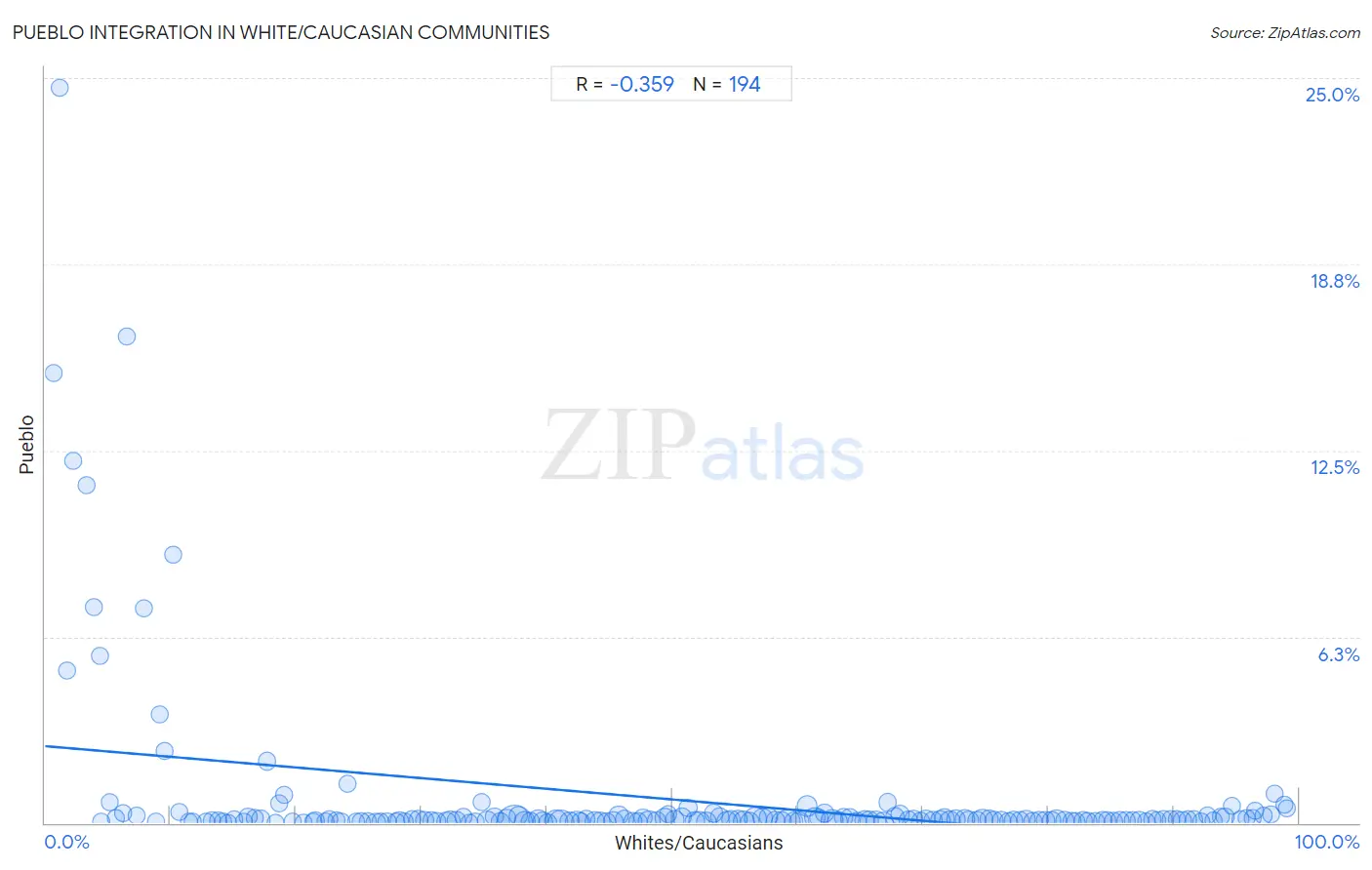
White/Caucasian vs Pueblo Income
When considering income, the most significant differences between White/Caucasian and Pueblo communities in the United States are seen in wage/income gap (28.5% compared to 20.7%, a difference of 37.9%), householder income ages 25 - 44 years ($91,668 compared to $68,910, a difference of 33.0%), and per capita income ($42,180 compared to $32,012, a difference of 31.8%). Conversely, both communities are more comparable in terms of householder income over 65 years ($58,847 compared to $52,930, a difference of 11.2%), householder income under 25 years ($50,336 compared to $45,018, a difference of 11.8%), and median female earnings ($37,531 compared to $32,564, a difference of 15.2%).

| Income Metric | White/Caucasian | Pueblo |
| Per Capita Income | Poor $42,180 | Tragic $32,012 |
| Median Family Income | Poor $99,800 | Tragic $76,880 |
| Median Household Income | Poor $82,029 | Tragic $64,692 |
| Median Earnings | Poor $45,197 | Tragic $36,859 |
| Median Male Earnings | Fair $53,925 | Tragic $41,314 |
| Median Female Earnings | Tragic $37,531 | Tragic $32,564 |
| Householder Age | Under 25 years | Tragic $50,336 | Tragic $45,018 |
| Householder Age | 25 - 44 years | Poor $91,668 | Tragic $68,910 |
| Householder Age | 45 - 64 years | Fair $98,091 | Tragic $75,601 |
| Householder Age | Over 65 years | Tragic $58,847 | Tragic $52,930 |
| Wage/Income Gap | Tragic 28.5% | Exceptional 20.7% |
White/Caucasian vs Pueblo Poverty
When considering poverty, the most significant differences between White/Caucasian and Pueblo communities in the United States are seen in married-couple family poverty (4.8% compared to 11.1%, a difference of 130.5%), family poverty (8.8% compared to 17.0%, a difference of 93.7%), and receiving food stamps (11.1% compared to 19.9%, a difference of 80.0%). Conversely, both communities are more comparable in terms of single father poverty (18.4% compared to 21.1%, a difference of 15.1%), single mother poverty (31.2% compared to 37.2%, a difference of 19.3%), and single female poverty (22.7% compared to 28.6%, a difference of 26.0%).
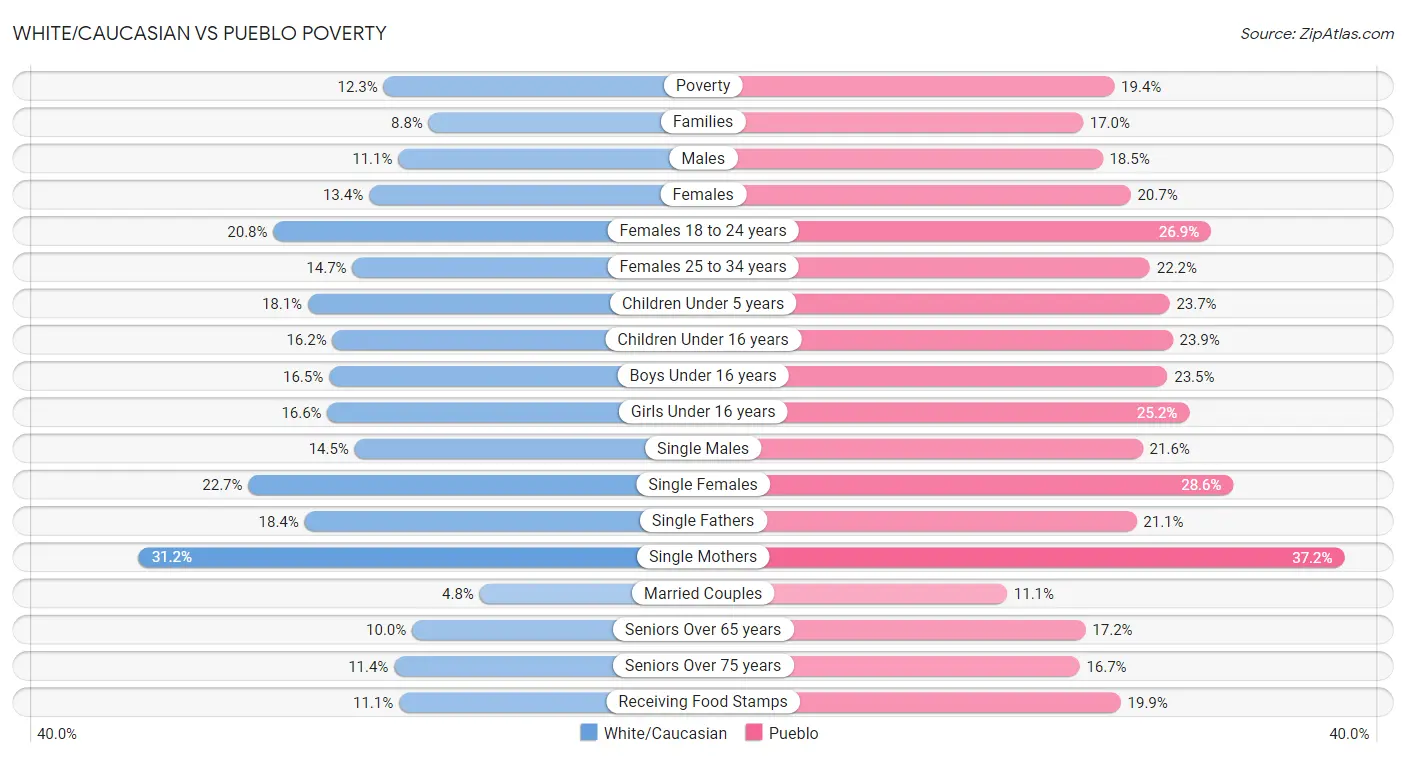
| Poverty Metric | White/Caucasian | Pueblo |
| Poverty | Average 12.3% | Tragic 19.4% |
| Families | Good 8.8% | Tragic 17.0% |
| Males | Average 11.1% | Tragic 18.5% |
| Females | Average 13.4% | Tragic 20.7% |
| Females 18 to 24 years | Tragic 20.8% | Tragic 26.9% |
| Females 25 to 34 years | Tragic 14.7% | Tragic 22.2% |
| Children Under 5 years | Poor 18.1% | Tragic 23.7% |
| Children Under 16 years | Average 16.2% | Tragic 23.9% |
| Boys Under 16 years | Average 16.5% | Tragic 23.5% |
| Girls Under 16 years | Average 16.6% | Tragic 25.2% |
| Single Males | Tragic 14.5% | Tragic 21.6% |
| Single Females | Tragic 22.7% | Tragic 28.6% |
| Single Fathers | Tragic 18.4% | Tragic 21.1% |
| Single Mothers | Tragic 31.2% | Tragic 37.2% |
| Married Couples | Exceptional 4.8% | Tragic 11.1% |
| Seniors Over 65 years | Exceptional 10.0% | Tragic 17.2% |
| Seniors Over 75 years | Exceptional 11.4% | Tragic 16.7% |
| Receiving Food Stamps | Excellent 11.1% | Tragic 19.9% |
White/Caucasian vs Pueblo Unemployment
When considering unemployment, the most significant differences between White/Caucasian and Pueblo communities in the United States are seen in male unemployment (5.0% compared to 8.5%, a difference of 68.8%), unemployment among ages 35 to 44 years (4.6% compared to 7.1%, a difference of 52.0%), and unemployment among ages 25 to 29 years (6.9% compared to 10.4%, a difference of 51.9%). Conversely, both communities are more comparable in terms of unemployment among ages 65 to 74 years (5.4% compared to 5.6%, a difference of 5.5%), unemployment among seniors over 65 years (5.1% compared to 5.4%, a difference of 7.1%), and unemployment among women with children under 6 years (8.4% compared to 9.1%, a difference of 8.9%).
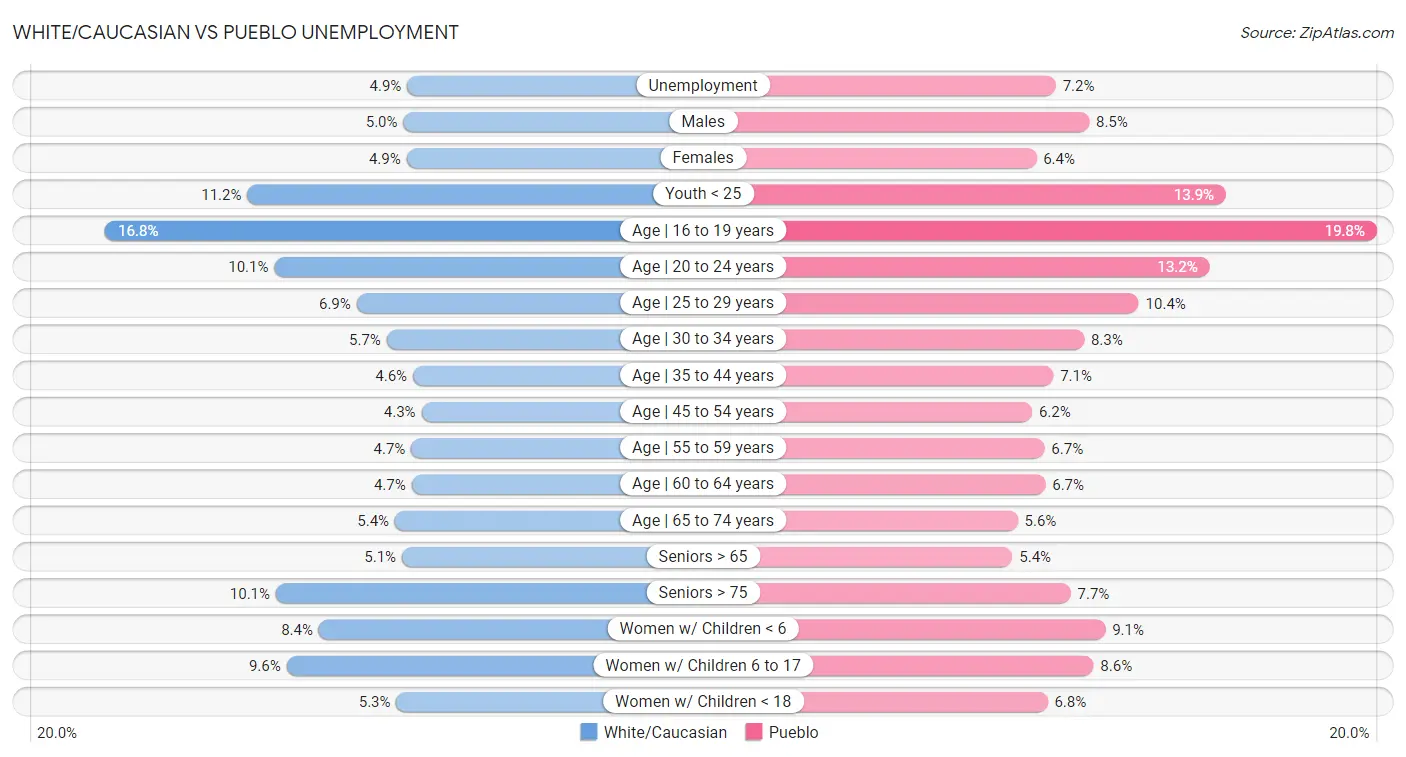
| Unemployment Metric | White/Caucasian | Pueblo |
| Unemployment | Exceptional 4.9% | Tragic 7.2% |
| Males | Exceptional 5.0% | Tragic 8.5% |
| Females | Exceptional 4.9% | Tragic 6.4% |
| Youth < 25 | Exceptional 11.2% | Tragic 13.9% |
| Age | 16 to 19 years | Exceptional 16.8% | Tragic 19.8% |
| Age | 20 to 24 years | Excellent 10.1% | Tragic 13.2% |
| Age | 25 to 29 years | Poor 6.9% | Tragic 10.4% |
| Age | 30 to 34 years | Tragic 5.7% | Tragic 8.3% |
| Age | 35 to 44 years | Good 4.6% | Tragic 7.1% |
| Age | 45 to 54 years | Exceptional 4.3% | Tragic 6.2% |
| Age | 55 to 59 years | Exceptional 4.7% | Tragic 6.7% |
| Age | 60 to 64 years | Exceptional 4.7% | Tragic 6.7% |
| Age | 65 to 74 years | Average 5.4% | Tragic 5.6% |
| Seniors > 65 | Excellent 5.1% | Tragic 5.4% |
| Seniors > 75 | Tragic 10.1% | Exceptional 7.7% |
| Women w/ Children < 6 | Tragic 8.4% | Tragic 9.1% |
| Women w/ Children 6 to 17 | Tragic 9.6% | Exceptional 8.6% |
| Women w/ Children < 18 | Excellent 5.3% | Tragic 6.8% |
White/Caucasian vs Pueblo Labor Participation
When considering labor participation, the most significant differences between White/Caucasian and Pueblo communities in the United States are seen in in labor force | age 16-19 (41.3% compared to 34.9%, a difference of 18.3%), in labor force | age 25-29 (84.2% compared to 77.5%, a difference of 8.6%), and in labor force | age 45-54 (81.9% compared to 75.5%, a difference of 8.4%). Conversely, both communities are more comparable in terms of in labor force | age 30-34 (83.9% compared to 80.0%, a difference of 4.8%), in labor force | age 20-24 (76.9% compared to 72.9%, a difference of 5.6%), and in labor force | age > 16 (63.6% compared to 59.3%, a difference of 7.3%).

| Labor Participation Metric | White/Caucasian | Pueblo |
| In Labor Force | Age > 16 | Tragic 63.6% | Tragic 59.3% |
| In Labor Force | Age 20-64 | Tragic 78.5% | Tragic 72.6% |
| In Labor Force | Age 16-19 | Exceptional 41.3% | Tragic 34.9% |
| In Labor Force | Age 20-24 | Exceptional 76.9% | Tragic 72.9% |
| In Labor Force | Age 25-29 | Tragic 84.2% | Tragic 77.5% |
| In Labor Force | Age 30-34 | Tragic 83.9% | Tragic 80.0% |
| In Labor Force | Age 35-44 | Tragic 83.6% | Tragic 77.4% |
| In Labor Force | Age 45-54 | Tragic 81.9% | Tragic 75.5% |
White/Caucasian vs Pueblo Family Structure
When considering family structure, the most significant differences between White/Caucasian and Pueblo communities in the United States are seen in births to unmarried women (33.3% compared to 53.7%, a difference of 61.4%), single father households (2.4% compared to 3.3%, a difference of 38.2%), and currently married (48.6% compared to 38.2%, a difference of 27.1%). Conversely, both communities are more comparable in terms of divorced or separated (12.6% compared to 12.7%, a difference of 0.83%), family households (65.1% compared to 68.2%, a difference of 4.8%), and family households with children (27.4% compared to 25.2%, a difference of 8.8%).

| Family Structure Metric | White/Caucasian | Pueblo |
| Family Households | Exceptional 65.1% | Exceptional 68.2% |
| Family Households with Children | Average 27.4% | Tragic 25.2% |
| Married-couple Households | Exceptional 48.6% | Tragic 40.0% |
| Average Family Size | Tragic 3.14 | Exceptional 3.79 |
| Single Father Households | Fair 2.4% | Tragic 3.3% |
| Single Mother Households | Good 6.1% | Tragic 7.4% |
| Currently Married | Exceptional 48.6% | Tragic 38.2% |
| Divorced or Separated | Tragic 12.6% | Tragic 12.7% |
| Births to Unmarried Women | Poor 33.3% | Tragic 53.7% |
White/Caucasian vs Pueblo Vehicle Availability
When considering vehicle availability, the most significant differences between White/Caucasian and Pueblo communities in the United States are seen in no vehicles in household (7.0% compared to 10.8%, a difference of 52.9%), 4 or more vehicles in household (7.4% compared to 8.6%, a difference of 16.5%), and 2 or more vehicles in household (60.8% compared to 57.5%, a difference of 5.8%). Conversely, both communities are more comparable in terms of 3 or more vehicles in household (22.6% compared to 23.0%, a difference of 2.0%), 1 or more vehicles in household (93.1% compared to 89.6%, a difference of 4.0%), and 2 or more vehicles in household (60.8% compared to 57.5%, a difference of 5.8%).

| Vehicle Availability Metric | White/Caucasian | Pueblo |
| No Vehicles Available | Exceptional 7.0% | Fair 10.8% |
| 1+ Vehicles Available | Exceptional 93.1% | Fair 89.6% |
| 2+ Vehicles Available | Exceptional 60.8% | Exceptional 57.5% |
| 3+ Vehicles Available | Exceptional 22.6% | Exceptional 23.0% |
| 4+ Vehicles Available | Exceptional 7.4% | Exceptional 8.6% |
White/Caucasian vs Pueblo Education Level
When considering education level, the most significant differences between White/Caucasian and Pueblo communities in the United States are seen in bachelor's degree (35.3% compared to 25.5%, a difference of 38.1%), master's degree (13.8% compared to 10.3%, a difference of 34.5%), and associate's degree (44.2% compared to 34.0%, a difference of 30.0%). Conversely, both communities are more comparable in terms of kindergarten (98.4% compared to 98.4%, a difference of 0.0%), 1st grade (98.4% compared to 98.4%, a difference of 0.0%), and nursery school (98.5% compared to 98.4%, a difference of 0.010%).
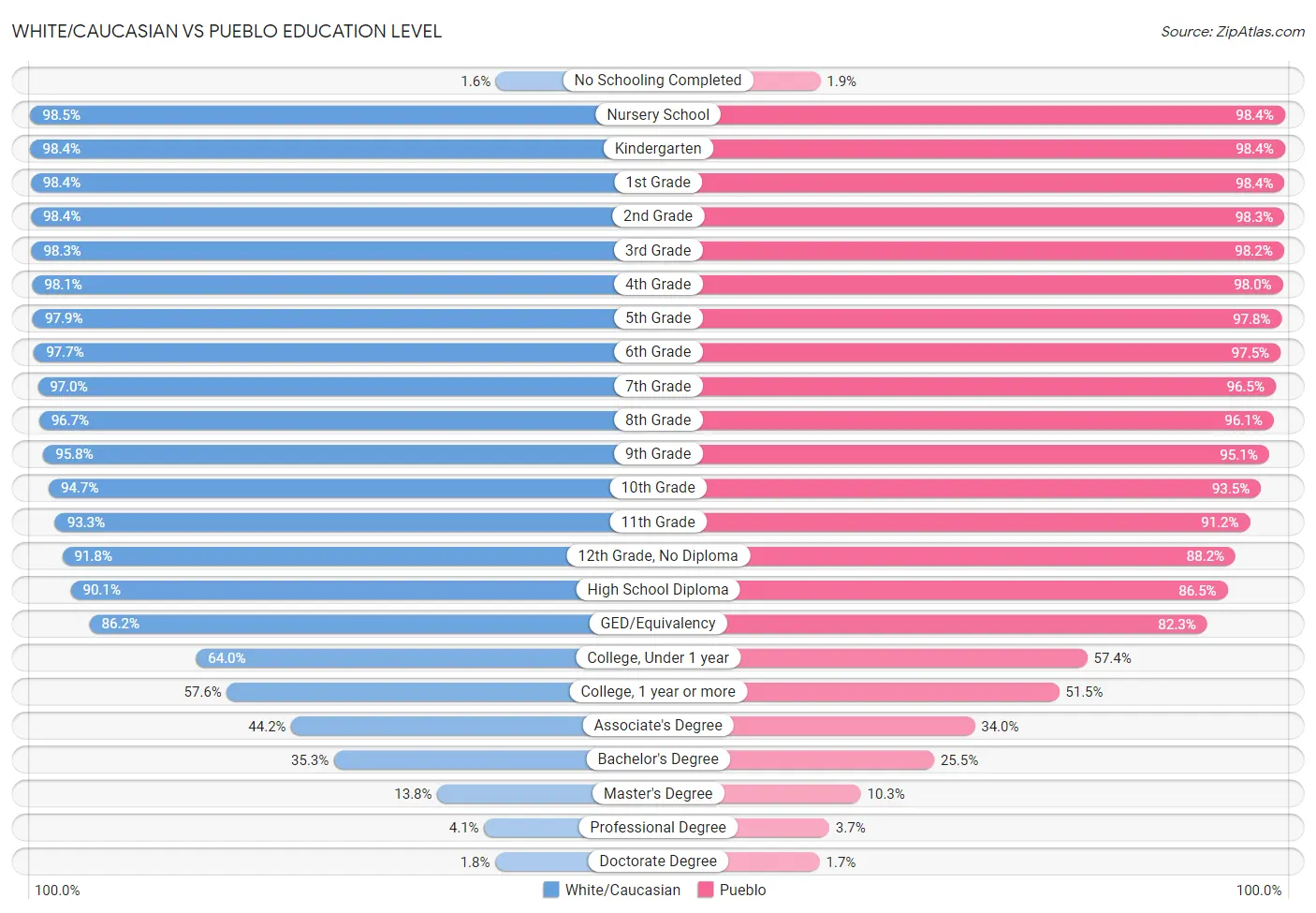
| Education Level Metric | White/Caucasian | Pueblo |
| No Schooling Completed | Exceptional 1.6% | Exceptional 1.9% |
| Nursery School | Exceptional 98.5% | Exceptional 98.4% |
| Kindergarten | Exceptional 98.4% | Exceptional 98.4% |
| 1st Grade | Exceptional 98.4% | Exceptional 98.4% |
| 2nd Grade | Exceptional 98.4% | Exceptional 98.3% |
| 3rd Grade | Exceptional 98.3% | Exceptional 98.2% |
| 4th Grade | Exceptional 98.1% | Exceptional 98.0% |
| 5th Grade | Exceptional 97.9% | Exceptional 97.8% |
| 6th Grade | Exceptional 97.7% | Exceptional 97.5% |
| 7th Grade | Exceptional 97.0% | Exceptional 96.5% |
| 8th Grade | Exceptional 96.7% | Exceptional 96.1% |
| 9th Grade | Exceptional 95.8% | Excellent 95.1% |
| 10th Grade | Exceptional 94.7% | Fair 93.5% |
| 11th Grade | Exceptional 93.3% | Tragic 91.2% |
| 12th Grade, No Diploma | Exceptional 91.8% | Tragic 88.2% |
| High School Diploma | Exceptional 90.1% | Tragic 86.5% |
| GED/Equivalency | Good 86.2% | Tragic 82.3% |
| College, Under 1 year | Poor 64.0% | Tragic 57.4% |
| College, 1 year or more | Tragic 57.6% | Tragic 51.5% |
| Associate's Degree | Tragic 44.2% | Tragic 34.0% |
| Bachelor's Degree | Tragic 35.3% | Tragic 25.5% |
| Master's Degree | Tragic 13.8% | Tragic 10.3% |
| Professional Degree | Poor 4.1% | Tragic 3.7% |
| Doctorate Degree | Fair 1.8% | Poor 1.7% |
White/Caucasian vs Pueblo Disability
When considering disability, the most significant differences between White/Caucasian and Pueblo communities in the United States are seen in vision disability (2.4% compared to 3.3%, a difference of 40.1%), disability age 65 to 74 (24.2% compared to 33.1%, a difference of 36.5%), and self-care disability (2.6% compared to 3.3%, a difference of 27.5%). Conversely, both communities are more comparable in terms of disability age 18 to 34 (7.6% compared to 7.7%, a difference of 0.90%), female disability (13.2% compared to 14.1%, a difference of 7.1%), and disability age 5 to 17 (6.2% compared to 5.7%, a difference of 9.4%).
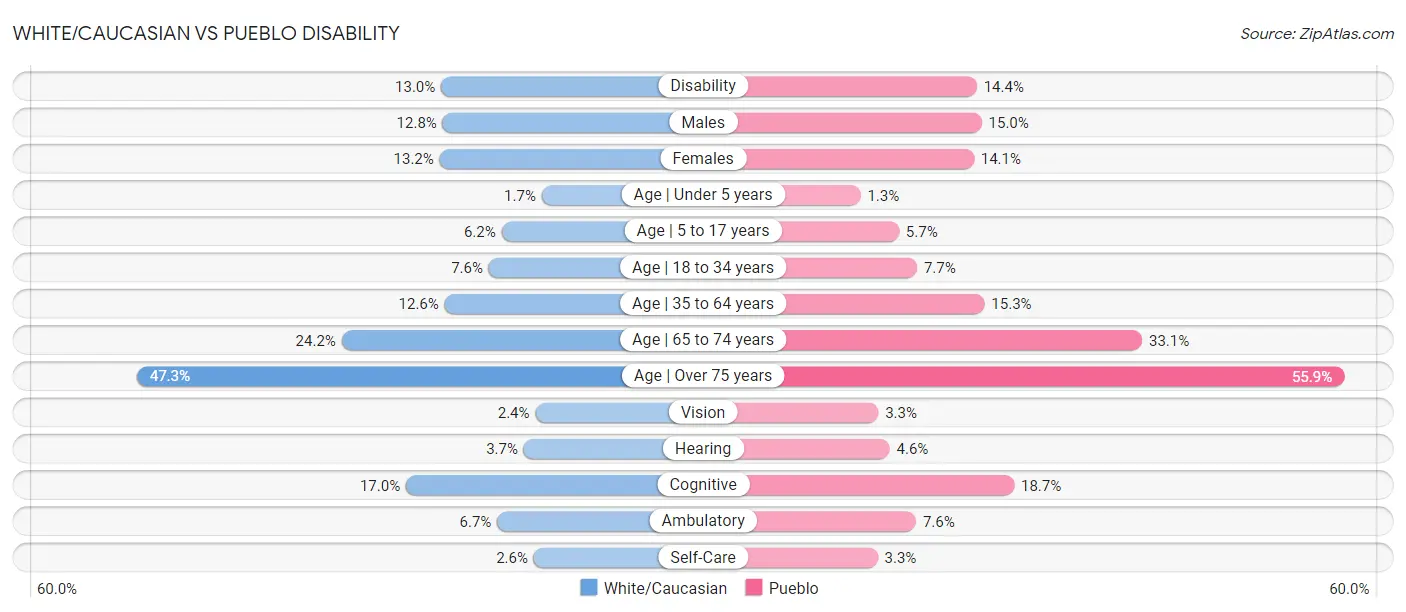
| Disability Metric | White/Caucasian | Pueblo |
| Disability | Tragic 13.0% | Tragic 14.4% |
| Males | Tragic 12.8% | Tragic 15.0% |
| Females | Tragic 13.2% | Tragic 14.1% |
| Age | Under 5 years | Tragic 1.7% | Tragic 1.3% |
| Age | 5 to 17 years | Tragic 6.2% | Fair 5.7% |
| Age | 18 to 34 years | Tragic 7.6% | Tragic 7.7% |
| Age | 35 to 64 years | Tragic 12.6% | Tragic 15.3% |
| Age | 65 to 74 years | Tragic 24.2% | Tragic 33.1% |
| Age | Over 75 years | Average 47.3% | Tragic 55.9% |
| Vision | Tragic 2.4% | Tragic 3.3% |
| Hearing | Tragic 3.7% | Tragic 4.6% |
| Cognitive | Exceptional 17.0% | Tragic 18.7% |
| Ambulatory | Tragic 6.7% | Tragic 7.6% |
| Self-Care | Tragic 2.6% | Tragic 3.3% |